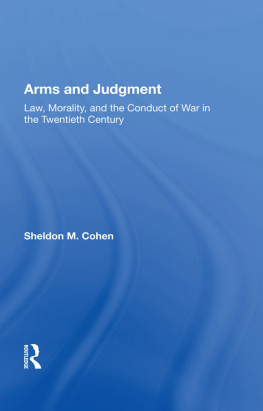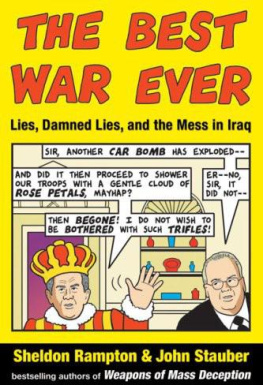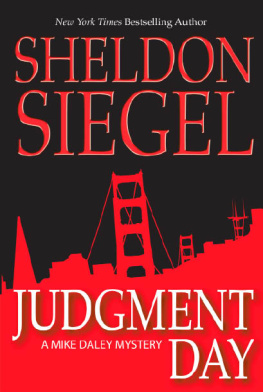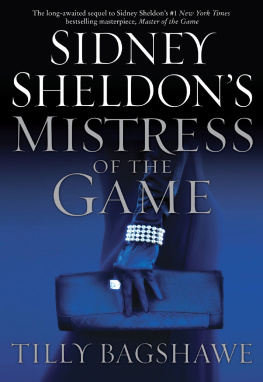First published 1989 by Westview Press
Published 2018 by Routledge
52 Vanderbilt Avenue, New York, NY 10017
2 Park Square, Milton Park, Abingdon, Oxon OX14 4RN
Routledge is an imprint of the Taylor & Francis Group, an informa business
Copyright 1989 by Taylor & Francis
All rights reserved. No part of this book may be reprinted or reproduced or utilised in any form or by any electronic, mechanical, or other means, now known or hereafter invented, including photocopying and recording, or in any information storage or retrieval system, without permission in writing from the publishers.
Notice:
Product or corporate names may be trademarks or registered trademarks, and are used only for identification and explanation without intent to infringe.
Library of Congress Cataloging-in-Publication Data
Cohen, Sheldon M.
Arms and judgment: law, morality, and the conduct of war in the
20th century / by Sheldon M. Cohen.
p. cm.
Bibliography: p.
Includes index.
ISBN 0-8133-0702-3. ISBN 0-81330703-1 (pbk.)
1. War (international law). 2. WarMoral and ethical aspects.
I. Title.
JX451l.C64 1989
341.6dc19
88-20670
CIP
ISBN 13: 978-0-367-00558-0 (hbk)
In April 1986 the Cable News Network was getting the reactions of passersby to the U.S. air strike against Libya. A young California woman expressed her concern: I feel that negative acts only lead to more negative acts.
It sounded like such a wholesome thought. But would she have thought it on the beach at Normandy on D day? Looking down at the great armada of ships disgorging tens of thousands of British, Canadian, and American troops for the final assault on Hitlers bastion-for most, their first time under fire, for many their last-watching as the big naval guns thundered at the coastal bunkers, would she have disapproved? As hundreds of planes roared overhead and the earth shook beneath her feet, as sleek destroyers darted in to silence the artillery firing at the landing craft, would she feel that these negative acts would only lead to more negative acts? Or was all this horror and sacrifice somehow for the good?
On the one hand we have the undeniable horrors of war and the repugnance they rightly evoke in decent people. War is not a good. It is a great, vivid evil.
But we also live in a world in which the weak are accustomed to being at the mercy of the strong and in which nations go unarmed only if they have powerful protectors. So it is important to inquire calmly into how the use of force can be morally justified, the circumstances in which it is warranted, and the degree of force they warrant. This book is an examination of those justifications and their limits. It is, then, a moral inquiry. But it adopts an interdisciplinary approach.
My first attempt to teach a course on war and morality proved to be nothing more than a review of basic themes in moral philosophy. War provided at most a context, at worst a pretext, for discussing points I would have covered in any introductory ethics course-an excuse for selling those goods under another label. That was unfair to the topic.
Modern warfare raises many complex issues that the ready-made, all-purpose distinctions with which philosophers instinctively approach moral questions cannot gain a purchase on. I decided to treat those issues anyway. I would cover the moral issues that really arise in the practice of war. If they reflected normal topics in ethical theory, fine; if not, they would have to be addressed on their own terms. The course would be a moral inquiry into twentieth-century military practice, not a general ethics course illustrated with examples from military history.
This pedagogical decision was, on another level, theoretical as well. Instead of coming to the discussion with my distinctions neatly lined up in the box, I wanted them to percolate out of the subject matter. I wanted the subject matter to generate them. An examination of the laws and customs of war provided the means for doing this. They are a product of attention to detail by soldiers and statesmen. Their nuances grew out of the details; their haggling is informed.
The laws and customs of war reflect the imperfect but subtle mesh between ideals and reality in the harsh terrain where nations clash. The principles that grow there are not principles a utopian world would accept. But then utopian principles count only as Mark Twain counted the coal dealers prayer for warm weather: as so much wind, useful to the angels only to drive the ships of the faithful.
The law of war provided the road map for the discussion, so this book examines that law. But legality and morality are different, and though the law may serve as a useful guide to morality, their two paths frequently diverge. Sometimes that divergence is academic; sometimes it is a question of life and death. This divergence, and its significance, is one of the underlying themes of this book. If a corporate officer engages in an immoral yet legal practice to boost his companys profits, we are inclined to grumble and shrug our shoulders. What should our response be when a legal but immoral military practice destroys a city? Do we want military commanders to do what is most effective so long as it is perfectly legal? Or do we want them to do what is morally right no matter what the cost?
This book is also laced with historical accounts. We cannot judge the morality of policies or practices without a reasonable acquaintance with the circumstances in which they arose. We cannot even understand what these policies and practices are without understanding some of the details. The real questions-the ones that do not begin with all other things being equal -cannot be answered with patent assertions about casualties or rights, civilian or military. They begin with an understanding of what the campaigns that raised these questions were like. Does military necessity justify the bombardment of inhabited towns? Did it justify the bombardment of St. 16? The Allied breakout from Normandy, the bomber campaign against Germany, the ground war in Vietnam-we have to understand these things before we can is the strategic air war in World War II, which leads us to another thematic concern: civilian immunity. The chapters are arranged historically according to the issues that became paramount in different decades. As a result, some of the questions philosophers typically ask are missing. Would it be morally justifiable to torture an innocent child to prevent a world war? That is an interesting question, but not the sort of question I address. My excuse is that no one is likely ever to be in that position. The questions I am interested in have confronted hundreds of thousands of people in the twentieth century. Some of these questions have not until now had much of a literature: Why is it permissible to camouflage a tank to look like a hot dog stand, but not to disguise its crew to look like hot dog vendors? Why is it permissible to destroy a citys center with aerial bombs, but not with car bombs? Why do the legal restraints on naval and ground forces differ? All of these questions should be of interest to anyone who wants to review our century from a moral point of view.
Sheldon M. Cohen









